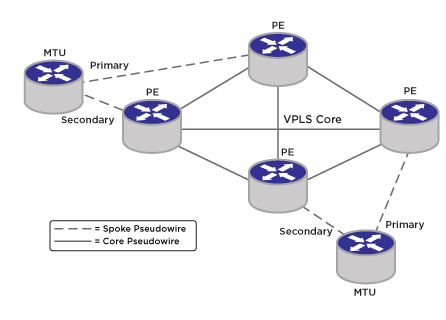Redundant Spoke Pseudowire Connections
Redundant spoke pseudowires to PE peers can be configured from an MTU to provide backup connectivity into a VPLS core.
The addition of a redundant spoke pseudowire is optional. By default, when the MPLS Feature Pack license has been applied to the switch, the spoke pseudowire to the primary peer is used to forward packets. In the event of a network failure over the primary pseudowire, the spoke pseudowire to the secondary peer is used to provide redundant VPLS connectivity. An example network is shown in Example H-VPLS Network with Redundant Spokes.

When both the primary and secondary pseudowires are established, the MTU is responsible for blocking the secondary pseudowire. Any packets received on the secondary pseudowire while the primary pseudowire is active are discarded. This behavior prevents packet-forwarding loops within the L2 VPN.
Since the MTU is responsible for choosing which pseudowire to the VPLS is active, the MTU is uniquely responsible for preventing network loops. The MTU uses only one spoke pseudowire per VPLS and only the label stack associated with the active pseudowire is programmed into the hardware. If the active pseudowire fails, then the label stack for the active pseudowire is removed from hardware. The secondary pseudowire label stack is then installed in the hardware in order to use the redundant VPLS link from the MTU into the VPLS core. Customer connectivity through the MTU should experience minimal disruption.
IETF RFC 6870 defines the "Preferential Forwarding" status bit to designate which pseudowire is active and can be used to forward user packets. The MTU sets this bit to indicate that a pseudowire is standby (not active) and should not be used to forward user packets.
When a failover occurs from a primary pseudowire to a secondary pseudowire, the MTU clears its FDB database of MAC addresses learned over the primary pseudowire. It then begins learning MAC addresses over the new active pseudowire. To inform other nodes to clear their learned MAC database, the MTU can send a MAC address-withdraw message (if this feature is enabled) to the peer PE node of the secondary pseudowire. This PE node can subsequently send its own MAC address-withdraw message to the other VPLS full-mesh core nodes. Upon receipt of the MAC address withdrawal message, each core node clears its database. In this manner, other core nodes re-learn MAC addresses from the correct pseudowire or port.
Packets can be received out-of-order by the VPLS destination device during certain pseudowire failover events. In the redundant VPLS spoke configuration, when the primary pseudowire fails, traffic is immediately switched to the secondary pseudowire. For a very short period of time, there may be packets that are in route via both pseudowires. No attempt to prevent mis-ordered packets from being received is made.
The command to configure the VPLS peer from an MTU to a PE and from a PE to an MTU is fundamentally the same. However, the optional primary and secondary pseudowire keywords are only applicable on the MTU since the MTU is responsible for preventing loops within the VPLS. A switch cannot be configured with a primary and a secondary pseudowire to the same peer within a VPLS. This is an invalid configuration since it provides no redundant protection for a failed PE node.

